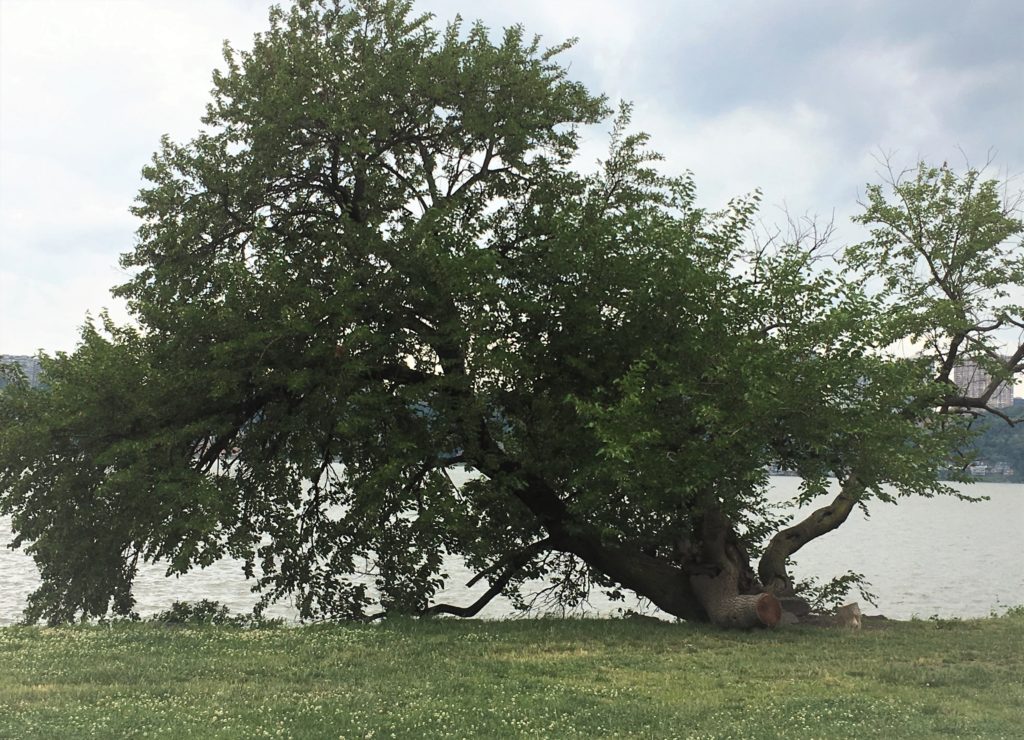I took a long walk with a friend alongside Hudson River. Every few feet, a fruit-laden mulberry tree was sustaining the wildlife while expanding its own territory. Young shrubs grew near old trees like multi-generation families. Most of them were the common red mulberries. Occasionally, a white one stood among them.


Watching mulberries ripen, fall and perish on the ground every year, I always wonder why the fruits are not harvested and put to better use. In a Chinese folk tale, 蔡順 (Cai Shun),[1] having lost his father at an early age, took on the responsibility of caring for his mother. During the warring period between Western and Eastern Han Dynasties[2], because of food shortage, he collected mulberries for nourishment. One day, he encountered 赤眉軍 (Chìméi, Red-Eyebrowed rebels). They noticed that he divided his small-quantity gathering into two baskets and asked him why. He said, “The black ones, ripe and sweet, are for my mother; the red, unripe, for myself.” The rebels, moved by his filial piety, offered him cows and rice, which he refused. The moral of the story is about filial piety as well as staying true to one’s principles. But, as a child, I was more curious about the taste of mulberries.
I don’t recall ever tasting mulberries in my youth. But I remember fondly of keeping silkworm (Bombyx mori) caterpillars and feeding them mulberry leaves. It was a common practice meant to teach children the importance of sericulture in Chinese history and the life cycle of silkworms.
Legend has it that Leizu (嫘祖, c. 2700 BC, aka Hsi-Ling-Shih 西陵氏),[3] wife of the Yellow Emperor (黃帝) [4].—the instituter of Chinese culture, invented silk farming. She taught people how to raise silkworms, collect the cocoons, dissolve them to obtain the threads. Although the existence of these mythical figures would be difficult to trace, early-twentieth-century archeological researches in Neolithic culture along the Yellow River, known as Yangshao culture (仰韶文化), found evidences of sericulture dated around 3000 BC.[5] Silk grew to be a symbol of power and wealth in China before being introduced to the world through the “silk road.”[6]
Every year, a new class of children will learn of the silk culture and will be encouraged to get a few silkworms in order to observe their life cycles. Even without suggestions from teachers, most children would raise the worms as their seasonal pets in spring time. Mom would take us to neighborhood corner store to pick up baby silkworms (蠶寶寶) in small paper containers. The dark-colored larvae were tiny. But they wiggled and fed on mulberry leaves vigorously. Robert and I made sure to put down new tissues for them daily, keeping them healthy and happy. We wiped fresh mulberry leaves, making sure that they were clean and dry, before placing them in the box. The earthy smell of the leaves would fill up the room. The larvae quickly became grayish-white-colored caterpillars. Every few days, as they grew to a certain size, they would stop feeding and stayed motionless to shed their skins—molting. Their appetite would increase with their size.
Eventually, one by one, after the fourth molting, they began twisting their bodies and wrapping themselves with transparent threads. At first, we could still see them through the threads. Gradually, the cocoons became solid, white and shiny, like little eggs.[7] We understood that the caterpillars would morph into pupae before becoming silk moths and breaking out of the cocoons. Mom explained to us that, in order to harvest the silky thread, one must throw the cocoons in hot water. She also told us that it would take many cocoons to produce beautiful silk fabric. So, year after year, not wanting to kill the pupae, we kept the cocoons intact. Out of curiosity, I often picked them up, listening to see if there might be any motions inside. A few times, we got to see the moths hanging around. Most years, having missed the right moment when the moth came out, we could only send off the empty cocoons with sadness. It was always my secret hope to see a whole cocoon dissolve into an endless thread, stretching out for miles.
Bombyx mori caterpillars are picky eaters. Although they will eat leaves of all varieties of mulberry (and Osage orange), those of white mulberries are preferable. I read that white mulberries were introduced to North America with the plan to establish silk industry here. The plan failed but the trees adapted to the New World and became part of the landscape. My friend and I walked casually, watching birds and squirrels busying themselves with fruits, pink, red, black. . . no matter. The differences between the native and the exotic species also matter very little to me. The sight of mulberry trees, leaves and fruits will always remind me of stories of childhood, of the images of those mysterious caterpillars that had long melted into my childhood dreams, and of my heritage.

[1] The_Twenty-four_Filial_Exemplars_二十四孝_Wiki
[2] In 9AD, 王莽 (Wang Mang), a powerful political figure of the Western Han Dynasty, taking advantage of the internal turmoil of the court, seized power and established 新朝 (New Dynasty). His rule was short-lived (9-23AD) and tumultuous. Farmers rose up and formed rebellion forces. The two major rebel groups were 赤眉軍(Red-Eyebrowed Army) and 綠林軍 (Green Forest Army).
[3] Leizu_Wiki
[4] Yellow_Emperor_Wiki
[5] Yangshao_culture#Archaeological_sites_Wiki
Silk History, Silk Road Foundation
[6] Silkworm-Life-Cycle-YouTube
[7] The “Silk Road” was a network of corridors connecting China, Far East, Middle East and Europe. Started as trade routes, it also played an important role in cultural exchange. Colin Thubron provided in-depth discussions on the history and presence of the Silk Road in Shadow of the Silk Road, first published by Chatto & Windus in Great Britain in 2006; by HarperCollins in U.S. in 2007 and reprinted by Random House in 2012.
